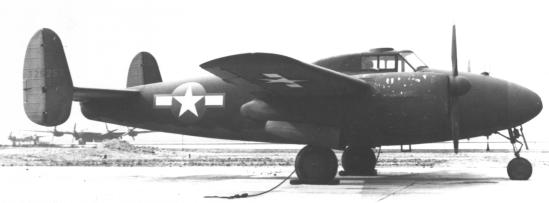Fairchild BQ-3
In October 1942, Fairchild received a contract to build two XBQ-3 prototype unmanned assault drones based on the AT-21 Gunner twin-engined trainer design. These drones, also called "aerial torpedoes" at that time, were to be fitted with a large payload of high-explosive, and directed to the target by radio commands from a control aircraft. The first flight of an XBQ-3 occurred in July 1944, but the XBQ-3 program was cancelled at some time later that year.
 |
| Photo: via Mitchell |
| XBQ-3 |
The XBQ-3 was powered by two Ranger V-770 piston engines, had a retractable tricycle landing gear, and was filled with 1800 kg (4000 lb) of high-explosive. The latter was twice as much as the purpose-designed, but smaller, Fleetwings BQ-1/BQ-2 drones. For test flights, it was flown with on-board pilots. Like the other BQ-series drones, the XBQ-3 was equipped with a TV camera, whose image would be used by the remote control operator to "fly" the drone.
Specifications
Note: Data given by several sources show slight variations. Figures given below may therefore be inaccurate!
Data for XBQ-3:
| Length | 16.05 m (52 ft 8 in) |
| Wingspan | 11.28 m (37 ft) |
| Height | 3.99 m (13 ft 1 in) |
| Weight | 6930 kg (15300 lb) |
| Speed | 355 km/h (220 mph) |
| Ceiling | 5200 m (17000 ft) |
| Range | 2400 km (1500 miles) |
| Propulsion | 2x Ranger V-770-15 piston engine; 385 kW (520 hp) each |
| Warhead | 1800 kg (4000 lb) high-explosive |
Main Sources
[1] Kenneth P.Werrell: "The Evolution of the Cruise Missile", Air University Press, 1985
[2] Kent A. Mitchell: "Fairchild Aircraft 1926-1987", Thompson, 1997
[3] John M. Andrade: "U.S. Military Aircraft Designations and Serials, 1909 to 1979", Midland Counties, 1979
[4] US Army Air Forces: "Army Aircraft Model Designations", 1946
Back to Directory of U.S. Military Rockets and Missiles, Appendix 1
Last Updated: 26 March 2003